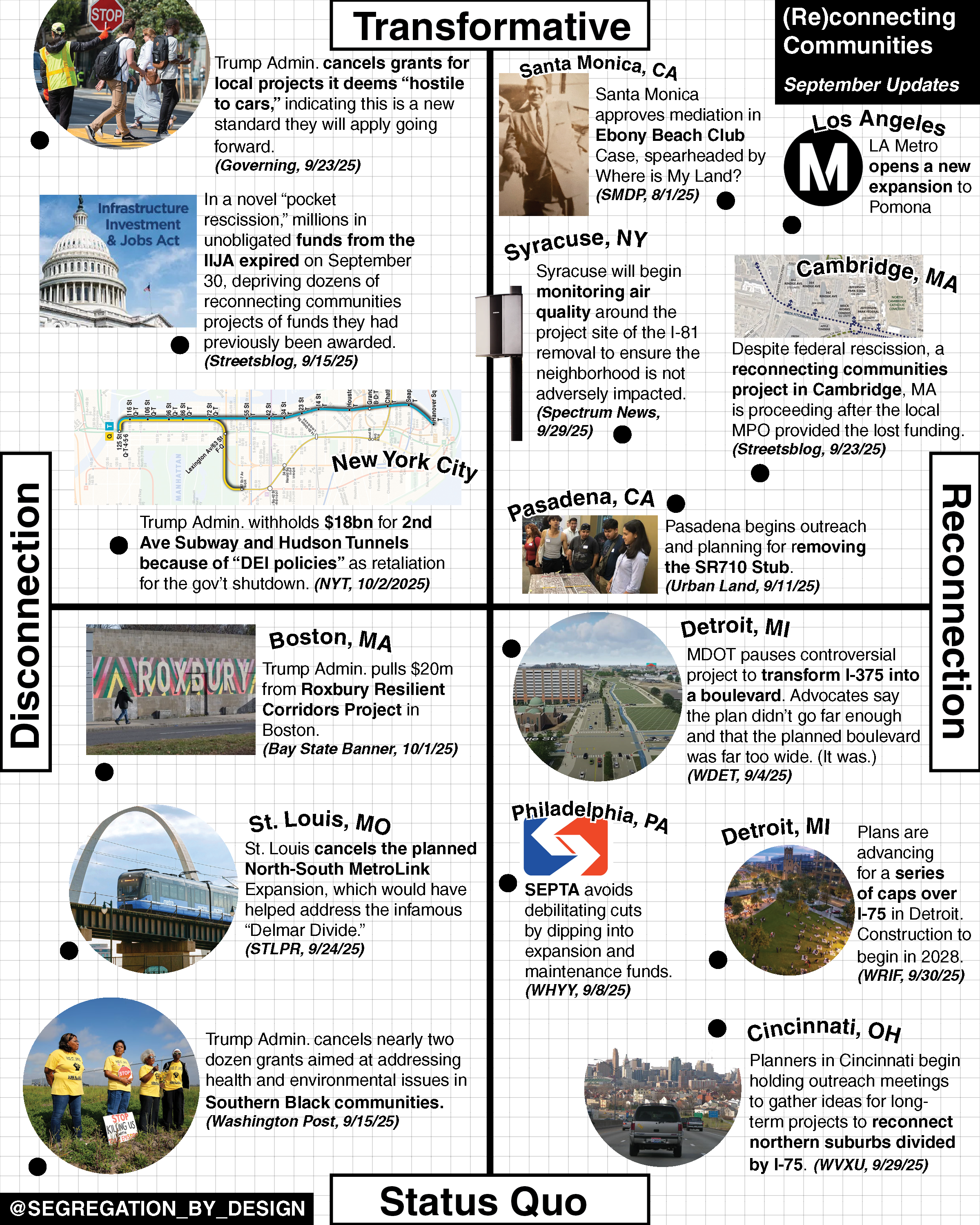(Re)Connecting Communities: September Update
Overview of last month’s “Reconnecting Communities” news, arrayed along two axes: one axis which positions an item based on whether it represents progress towards reconnection, or the opposite; and another axis which (for better or worse) compares whether an item represents transformative change vs. something more ingrained in the status quo.
On the “Reconnecting” side are developments which are progress away from the legacy of “Segregation by Design.” These include projects which advance spatial justice, such as large-scale infrastructure redesigns for more equitable mobility/land-use/housing, legal victories for affected communities, reparative actions, etc. On the other hand, “Disconnection” is defined as items that are further retrenchment of exclusionary urban design and environmental racism.
Items on the “Transformative” half are developments that move away from present systems and procedures, potentially resulting in fundamental shifts to existing institutions and practices (again, for better or worse). This includes news involving novel legal arguments, funding mechanisms, infrastructure and design approaches, etc., or which indicate structural/long-term shifts to present institutions. On the other hand, “Status Quo” developments involve making use of established processes and represent less radical departures from existing systems.
This is by no means meant to be a scientific ranking or an exhaustive list. I was out of town for a few weeks and needed to catch up on the news. I’m a fan of the “approval matrix” which New York Magazine puts out regarding news/pop culture and thought something similar could be a useful framework for reparative infrastructure developments (without hopefully being too glib).
Long story short: things are about as bad as they could be federally, but there is still some local/state progress being made in cities across the country (though the feds are increasingly coming after local/state funding too). Until the federal issue is sorted out, if we want to keep making progress towards a more equitable built environment, more state and local governments are going to have to follow the Boston MPO’s lead and step up to provide funding. Aside from the self-evident moral imperative to right past harms and present injustices (and health hazards), in the long-run reconnecting communities projects can pay for themselves by fostering strong, healthy, diverse neighborhoods (instead of money-sink highways and gutted downtowns).
Links:
Transformative Disconnection
Trump Cancels Grants for Pedestrian Safety, Bike Lanes (Governing)
How Millions For Transit, Walking, and Biking Could Vanish On Sept. 30 (Streetsblog)
Trump to Withhold $18 Billion for New York-Area Transit Projects (NYT)
Transformative Reconnection
Santa Monica Council Approves Mediation in Historic Beach Club Case (SMDP)
Metro’s A Line is long. It’s about to get longer with new stops opening in San Gabriel Valley (LAist)
I-81 road construction spurs air quality monitoring efforts (Spectrum)
Trump’s Budget Cuts Won’t Stop Cambridge From Bridging Its Communities (Streetsblog)
Reconnecting Communities: Pasadena planning for an equitable and resilient city of the future (Urban Land)
Status Quo Disconnection
Department of Transportation axes $20 million in grants intended for Roxbury transit infrastructure upgrades (Bay State Banner)
St. Louis cancels north-south MetroLink expansion project (STLPR)
Black communities, shaken by Trump cuts, feel ‘left behind again’ (WaPo)
Status Quo Reconnection
The Metro: Could I-375 pause rekindle Detroit’s fight for real repair? (WDET)
SEPTA avoids cuts for another 2 years. Pa. agency grants request for SEPTA to use maintenance funds (WHYY)
Detroit Plans to Build Three Park-Covered Bridges Over I-75 to Connect Downtown Areas (WRIF)
Planners want to reconnect 6 Hamilton County communities divided by railroads and highways (WVXU)
